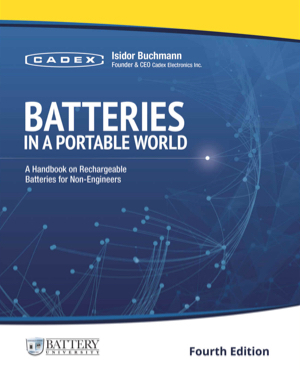“What can I do to keep my batteries longer?” many people ask. As folks stay fit by refraining from smoking, lowering sugar intake and exercising, so also can battery life be extended. There are no hard numbers as to how effective good care is, but the proof is in examples where packs were issued as personal goods as opposed to stock items. Personal care almost always wins
Table 1 summarizes how to prolong battery life through proper attention. Because of similarities within systems, the chemistries are limited to lead, nickel and lithium.
| Battery Care |
Lead Acid
(Flooded, Sealed, Gel, AGM) |
Nickel-Based
(NiCd, NiMH) |
Lithium-Ion
(Cobalt, Manganese, NMC) |
|---|
Best way
to charge |
- Apply saturated charge to prevent sulfation.
- Can remain on charge with correct float voltage.
|
- Avoid getting battery too hot on charge.
- Do not leave battery in charger for more than a few days subject to memory.
|
- Partial and random charge is fine.
- Does not need full charge.
- Lower voltage limit preferred.
- Keep battery cool.
|
| Charge methods |
- Constant voltage to 2.40–2.45/cell, float at 2.25–2.30V/cell.
- Battery should stay cool.
- No fast charge as much as possible.
- Charge time 14–16h.
|
- Constant current, NiCd can be fast charged without stress
- Trickle charge at 0.05C.
Slow charge = 14h
Rapid charge = 3h*
Fast charge = 1h* NiCd
* Recommended
|
- Constant voltage to 4.20V/cell.
- No trickle charge.
- Battery can stay in a charger.
- Rapid charge = 3h*
Fast charge = 1h
* Recommended
|
| Discharge |
- Can endure high peak currents.
- Avoid full discharges.
- Charge after each use.
|
- Do not over-discharge with a heavy load.
- Cell reversal causes short.
- Avoid full discharges.
|
- Prevent full cycles by applying some charges after a full discharge to keep the protection circuit alive.
|
| How to prolong battery |
- Limit deep cycling.
- Do not deep-cycle starter battery.
- Apply fully saturation charge.
- Avoid heat.
|
- Discharge batteries that are in regular use (mainly NiCd) to 1V/cell every 1–3 months to prevent memory.
|
- Keep cool.
- Operate in mid SoC of 30–80%.
- Prevent ultra-fast charging and high loads (most Li-ion).
|
| Transport |
|
|
|
| Storage |
- Keep cells at >2.05V.
- Apply topping charge** every 6 months to prevent sulfation.
|
- Store in cool place.
- NiCd stores for 5 years.
- Prime before use
|
- Store at 40% charge in cool place (40% SoC reads 3.75–3.80V/cell).
- Do not go below 2.0V/cell.
|
| Disposal |
- Toxic: Do not dispose. Electrolyte corrosive.
- Profitable to recycle.
|
- NiCd: Do not dispose.
- NiMH: May be disposed in low volume.
|
- Low toxicity.
- Can be disposed in low volume.
- Best to recycle.
|
Table 1: Do’s and don’ts summary of how to use, maintain and dispose of batteries
** Topping charge is applied on a battery that is in service or storage to maintain full charge and to prevent sulfation on lead acid batteries.
| CAUTION |
Under no circumstances should batteries be incinerated, as fire can cause an explosion. Wear approved gloves when touching electrolyte.
On exposure to skin, flush with water immediately. If eye exposure occurs, flush with water for 15 minutes and consult a physician immediately. |
Batteries In A Portable World
The material on Battery University is based on the indispensable new 4th edition of "Batteries in a Portable World - A Handbook on Rechargeable Batteries for Non-Engineers" which is available for order through Amazon.com.


I have changed hundreds of battery systems out in the oil and gas industry as well as other industrial facilities mostly solar and wind charging and have studied the effects. The systems usually last 3 to 4 years if you have good photovoltaic cells and positioning is optimal. I have found any type of resistance load or inductive load is not good and cuts life by at least 80% in a high demand situation thus for leaving the user with the reality of a bad choice. And the extreme cold was much worse when the seasons changed. Hence welcome to Wyoming. Yea fact I whitenesses it and did not enjoy changing out 110 amp batteries every day. The sun savers and solar panels were not the problem. Batteries are ok for data acquisition that was all, and small power outputs on and off. Lead could at least be recycled lithium ion needs help in that region. And I found when I went ice fishing lithium ion lasted about 20+ or - % longer. Yes EL FACTO. So it’s not near as peachy as green advocates push. And by the way this is coming from a licensed master electrician and also teach theory so there is no argument.